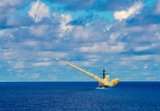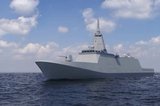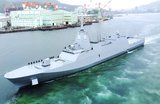Spain says farewell to the last of its Galerna-class submarines
The decommissioning of the Tramontana took place in Cartagena. (Photo: Spanish Navy)
Spain has decommissioned the last of its four Galerna-class conventional submarines, leaving the force with a single active submarine, a situation caused by 10 years of delays in introducing a new class of boats.
Tramontana was delivered in 1984 and underwent a major refit between 2014 and 2017, a programme led by Navantia. It sailed a total of 315,144nm, 218,384nm of that underwater.
The boat had participated in many national and international operations and exercises including the launching of a torpedo that sank a surface ship in October 2004.
The submarine also contributed to the outcome of the crisis of Perejil Island in 2002. Other interventions include her participation in operation ‘Unified Protector’ in Libya in 2001, as well as many NATO and EU-led missions.
In November 2023, Spanish shipbuilder Navantia delivered the first of four new ocean-going submarines that will provide the Spanish Navy with a long-awaited modern diesel-electric attack submarine (SSK) capability for the 21st century.
The S-80A Plus submarines are advanced SSKs that can conduct anti-submarine warfare, anti-surface warfare and perform an intelligence, surveillance and reconnaissance role. They have the potential for an added land-attack capability in the future with the acquisition of the Tomahawk cruise missile.
At the commissioning of Isaac Peral (S-81) Navantia stated that the second boat, Narciso Monturiol (S-82), was having the sections of its hull joined together at the same time as Cosme García (S-83) and Mateo García de los Reyes (S-84). The boats will be delivered in 2024, 2026 and 2027, respectively.
More from Naval Warfare
-
![NATO tests use of “undetectable, jam-proof” laser communication in maritime scenarios]()
NATO tests use of “undetectable, jam-proof” laser communication in maritime scenarios
As part of its effort to better prepare its capabilities for operations in contested and congested scenarios, NATO evaluated a Lithuanian ship-to-ship terminal designed to not be susceptible to enemy interference.
-
![Mitsubishi eyes future with Australia’s Mogami selection]()
Mitsubishi eyes future with Australia’s Mogami selection
With Australia’s selection of the Mogami-class for Project Sea 3000, Mitsubishi is investigating local production in the next decade as potential export opportunities emerge.
-
![Hanwha wins Australian government approval to increase its stake in Austal]()
Hanwha wins Australian government approval to increase its stake in Austal
The contract would mean the two shipbuilders can collaborate strategically and enhance shipbuilding capabilities in Western Australia.






















